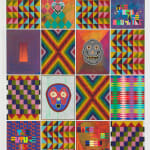Jeffrey Gibson USA, b. 1972
MAKE ME FEEL IT, 2021
Canvas, Acrylic Paint, Vintage Beaded Barrette, Glass Beads, Artificial Sinew, Tumbled Stone Beads, Plastic Beads, Wooden Beads, Cross Pearl Pendants, Nylon Thread
66 1/2 x 50 1/2 x 3 1/4 in
168.9 x 128.3 x 8.3 cm
168.9 x 128.3 x 8.3 cm
7994
Further images
-
(View a larger image of thumbnail 1
)

-
(View a larger image of thumbnail 2
)

-
(View a larger image of thumbnail 3
)

-
(View a larger image of thumbnail 4
)

-
(View a larger image of thumbnail 5
)

-
(View a larger image of thumbnail 6
)

-
(View a larger image of thumbnail 7
)

-
(View a larger image of thumbnail 8
)

-
(View a larger image of thumbnail 9
)

Jeffrey Gibson (b. 1972, USA) is a multi-disciplinary artist whose work explores the contemporary confluence of Modernism, personal identity, culture, history, and international social narratives. Gibson is a member of...
Jeffrey Gibson (b. 1972, USA) is a multi-disciplinary artist whose work explores the contemporary confluence of Modernism, personal identity, culture, history, and international social narratives. Gibson is a member of the Chocktaw and Cherokee nations. He currently lives and works in Hudson, New York. Gibson’s practice has manifested across several dynamic and diverse bodies of work, in which materials traditional to Native American art, such as animal hides, beads, and tipi poles, intermingle with materials like spray paint, acrylics, ceramic, and tape.
Gibson's latest body of paneled wall works represents a powerful and transformative moment in the evolution of his aesthetic position. Materially and conceptually, they are the culmination of more than two decades of rigorous experimentation.
Gibson's interest in the legacy and heritage of Modernism shines through in multiple ways, particularly in his use of the grid as an overriding aesthetic structure. Each section of the grid itself represents an additional layer of material and conceptual deconstruction. Text is incorporated in multiple sections of the grid. A careful reading of the text points the viewer towards references echoing Gibson's longstanding interest in poetry, literature, punk, rave, and club culture. Meanwhile, each letter of the texts is itself pared down into an abstracted, formal composition.
As the history of geometric abstraction is referenced throughout these compositions in ways that dynamically intersect with the aesthetic heritage of indigenous art, appropriated images of Native Americans interrogate the cultural tropes viewers typically associate with indigenous art. The figurative Native representations raise critical questions about a culture that embraces what Gibson does, while simultaneously pressuring him and other indigenous artists to continue performing to outdated, colonial expectations and stereotypes.
Gibson's latest body of paneled wall works represents a powerful and transformative moment in the evolution of his aesthetic position. Materially and conceptually, they are the culmination of more than two decades of rigorous experimentation.
Gibson's interest in the legacy and heritage of Modernism shines through in multiple ways, particularly in his use of the grid as an overriding aesthetic structure. Each section of the grid itself represents an additional layer of material and conceptual deconstruction. Text is incorporated in multiple sections of the grid. A careful reading of the text points the viewer towards references echoing Gibson's longstanding interest in poetry, literature, punk, rave, and club culture. Meanwhile, each letter of the texts is itself pared down into an abstracted, formal composition.
As the history of geometric abstraction is referenced throughout these compositions in ways that dynamically intersect with the aesthetic heritage of indigenous art, appropriated images of Native Americans interrogate the cultural tropes viewers typically associate with indigenous art. The figurative Native representations raise critical questions about a culture that embraces what Gibson does, while simultaneously pressuring him and other indigenous artists to continue performing to outdated, colonial expectations and stereotypes.








